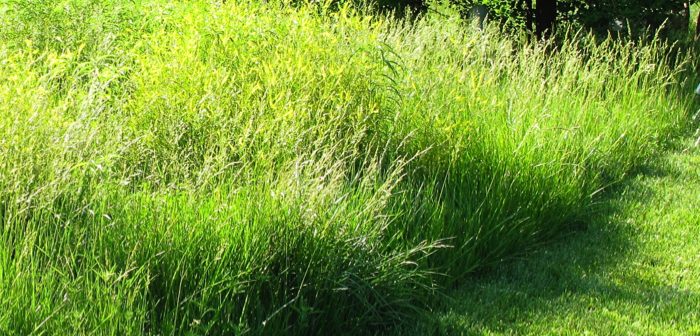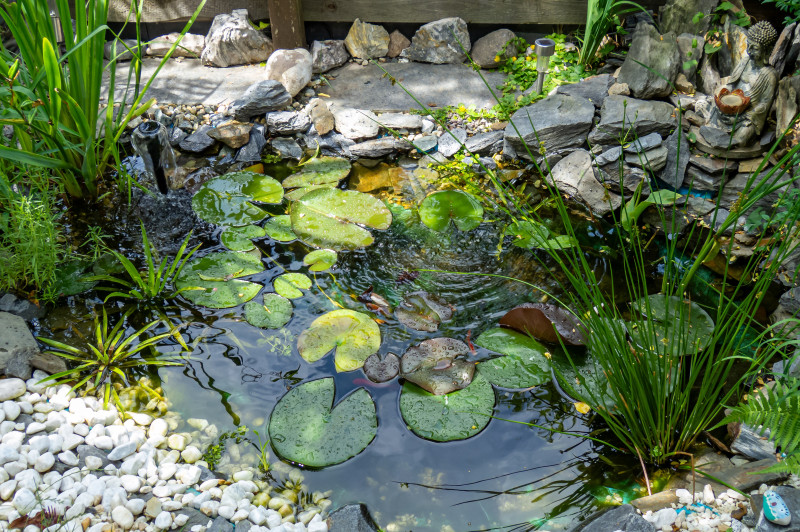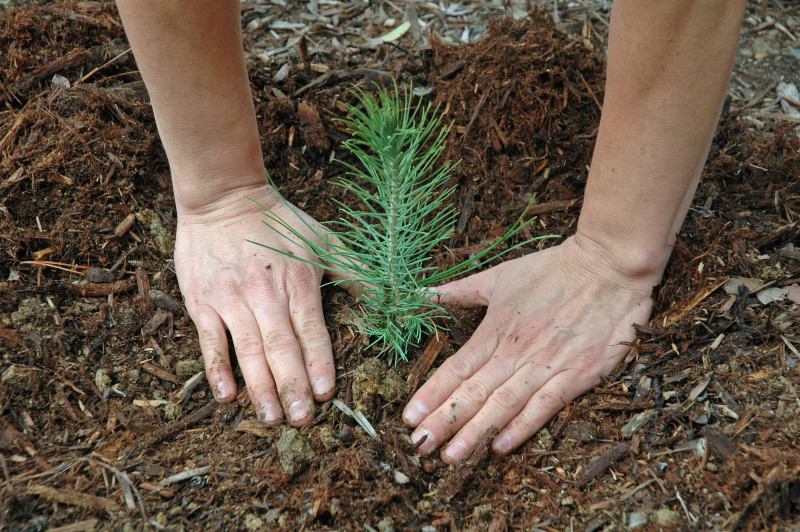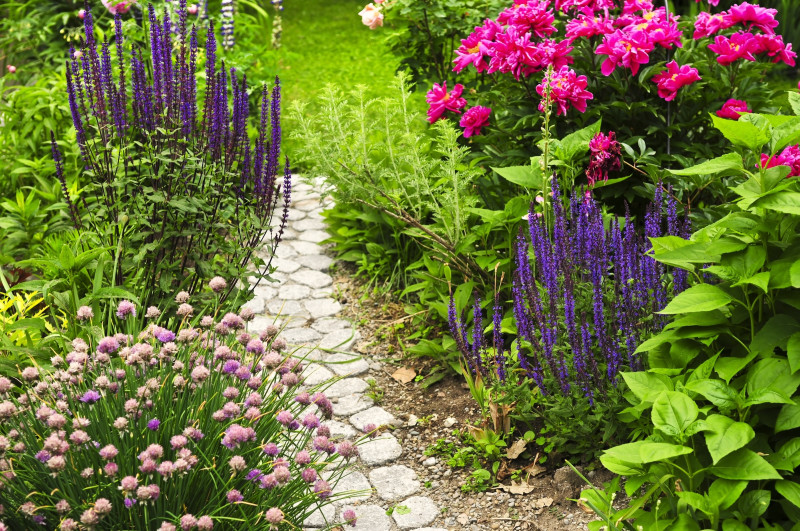Swaying gracefully in the gentlest breeze, native grasses seem to be the “free spirits” of plantdom. Their looks, though, are deceiving—they’re actually some of nature’s workhorses, providing food in the form of foliage and seeds, nesting places and nesting materials, and thick cover for wildlife to hide in. Here are some ways to use them:
- Group them in your butterfly garden
- Use them as a border to your property or lawn
- Plant them as a background behind native perennial
- Flank your walkways, sidewalk, patio, or driveway with them
Native grasses originated on the Great Plains, which was a lush 170 million acres of grasses back then. The topsoil was the deepest recorded anywhere and home to bison, elk, deer and other mammals, birds, butterflies, and countless other insects. For thousands of years, the prairies withstood all that nature threw at them—fire, flood, drought, tornadoes. Then came humans
Within a single generation, all but about 4 percent of prairies had been wiped out as they were plowed under for farming and built upon by developers. Ninety-six percent of that precious wildlife habitat is gone, making it all the more vital that we help to put some of it back, if only in our own yards.
Featured here are the best native grasses for the city. They benefit wildlife and the environment, and their size is suitable. Note that most native grasses don’t make a visual splash when planted singly, as do some of the pretty hybrids sold in garden centers. And they also don’t provide when planted alone. So plant native grasses in masses. Allow them time to grow and fill their bedding area—they’ll show off their own unique, wildly casual beauty, adding complexity and interest to your yard while, most importantly, helping wildlife.
BUFFALOGRASS
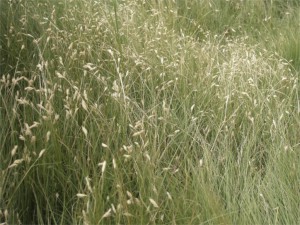 |
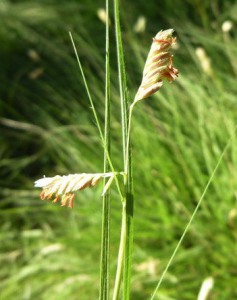 |
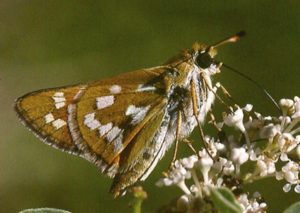 |
Buffalograss, Bouteloua dactyloides, is attractive, fine-bladed, soft, easy to maintain, exceptionally heat and cold-tolerant, and handles drought and clay—what’s not to like about it? A sod-forming grass that grows about 5 inches (13 cm) tall in northern areas and to 12 inches (30 cm) in southern regions, plant it in front of other native grasses. Don’t mow it so that it will produce seed heads to thicken the turf.
Several cultivars offer greater density and longer-lasting seasonal color. One of them, “Stampede,” gets only 4 inches (10 cm) tall. Buffalograss needs only 1-1/2 inches (4 cm) of water per month to stay green; otherwise, it goes dormant. If you mix it with Blue Grama (see below), the most drought-tolerant of all grasses, you’ll be assured of solid color through the dry season. It requires full sun and doesn’t like wet or sandy soil.
Green Skippers, Hesperia viridis, shown above, will use it as a host plant for their caterpillars. It also can be used as a pretty, environmentally friendly turfgrass in other areas of your yard. Zones: All. (Photos clockwise from top-left: Colorado Art Studio / Flickr – CC BY-NC-ND 2.0; Zoya Akulova / EOL – CC BY-NC 3.0; Jim P. Brock / EOL – CC BY-NC-SA 3.0)
BLUE GRAMA
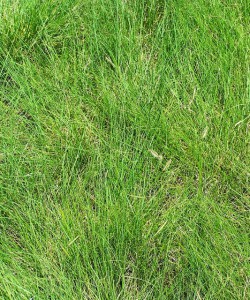 |
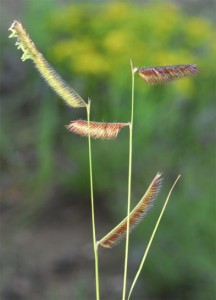 |
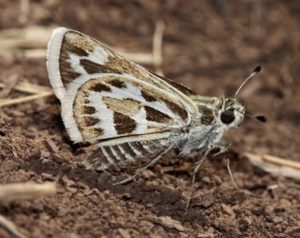 |
Blue Grama Grass, Bouteloua gracilis, makes up 75 percent or more of the grasses in tallgrass prairies. It forms dense mounds with foliage that grows to only about 4–6 inches (10–15 cm) tall. It works well at the front edge of other grasses or in front of dark-colored perennials that will help show off its interesting seed heads that grow about 15 inches (38 cm) tall and resemble eyelashes. And it can also be used as a turfgrass mixed with Buffalograss. (If your area of short native grasses won’t be mowed through the summer, sprinkle in some delicate nectar-producing wildflowers, too.) Blooms July to October. The most drought-tolerant of all native grasses, it can grow in any soil that isn’t highly organic and has good drainage. Full sun. Moisture: dry. Zones 5 to 9.
Several skipper species, including the Rhesus Skipper, Polites rhesus, shown above, use it as a host plant for their caterpillars. Songbirds eat its seeds, and deer and rabbits eat its foliage. (photos clockwise from top-left: S.E. Wilco / Wiki – CC BY-SA 3.0; Robert Sivinski / EOL – CC BY-NC 3.0; Bill Bouton / EOL – CC BY-SA 3.0)
LITTLE BLUESTEM (Schizachyrium scoparium)
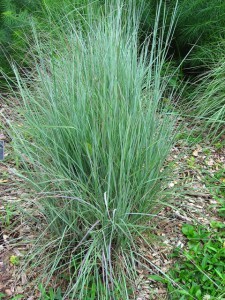 |
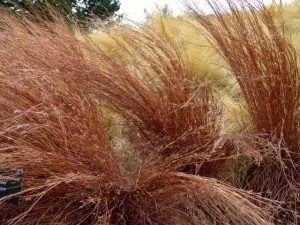 |
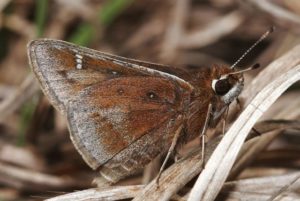 |
Little Bluestem, 2–3 feet (5–8 cm) tall, is a bunchgrass that makes an excellent companion to Big Bluestem, Indiangrass, and Switchgrass. Blue-green summer foliage changes to a bronze or red color in fall, which may linger through winter. Blooms from August to October. Prefers sun and well-drained soil. Zones 3-10.
Its narrow blades are food for larvae of butterflies, such as the Dusted skipper (Atrytonopsis hianna), shown above, and its seeds provide food for birds through the winter. (photos L-R: Chhe / Wiki – PD; Drew Avery / Flickr – CC BY 2.0; Dusted Skipper by Bill Bouton / EOL – 3.0 CC BY-SA 3.0)
SEA OATS
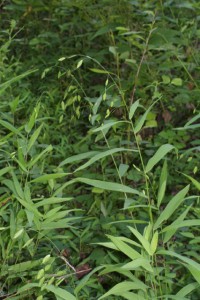 |
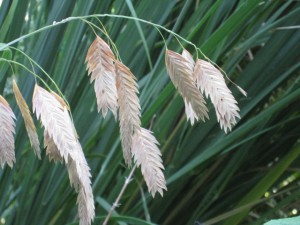 |
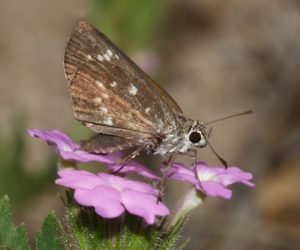 |
Sea Oats, Chasmanthium latifolium, is also called Indian Wood Oats, Wild Oats, River Oats, Flathead Oats, Upland Oats, or Upland Sea Oats. It’s one of the most popular native grasses for an urban yard. Growing 2–4 feet (5–10 cm) tall, the foliage is blue-green in spring and turns a vivid green by early summer, then translucent green seed heads turn to ivory in mid-summer. It’s a larval host for the Bronzed Roadside Skipper, Amblyscirtes aenus, and birds eat its seeds. Plant it where you won’t mind it spreading, as it readily re-seeds and produces deep, hard-to-pull roots. Blooms from June to September. Needs Sun to part shade. Tolerates difficult growing conditions, such as clay and rock subsoil and poor drainage. Zones 6-11.
It’s unlawful to collect Sea Oats seeds or plants from the wild in some states, but seeds can be purchased legally and are available on the internet. (photos clockwise from top-left: Steven J. Baskauf / EOL – CC BY-NC-SA 3.0; Anne McCormack / Flickr – CC BY-NC 2.0; Tom Murray / BugGuide – CC BY-NC-ND 1.0)
SWITCHGRASS
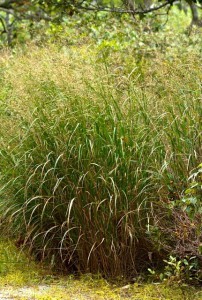 |
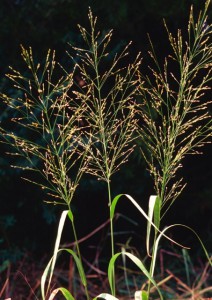 |
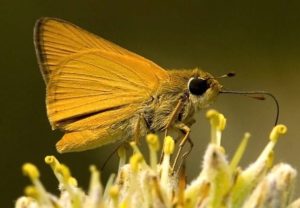 |
Switchgrass, Panicum virgatum, also called Wand Panic Grass, is a perennial bunchgrass often used as an ornamental, but its greatest importance is as dense cover and food for wildlife. It’s adaptable to all soil types and weather extremes. 3–6 feet (1–2 m) tall. Blooms from August to September, and the stems are good at standing up over the winter. Full sun. Moisture: dry to moist. Zones 3-10.
Switchgrass is a larval host for the Delaware Skipper, Anatrytone logan, shown above, and other skippers. (photos clockwise from top-left: L-R: Tom Potterfield / Flickr – CC BY-NC-SA 2.0; James H. Miller & Ted Bodner / Bugwood – CC BY 3.0; Bill Berthet / EOL – CC BY-NC 3.0)
BOTTLEBRUSH GRASS
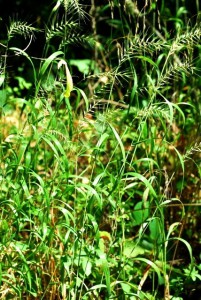 |
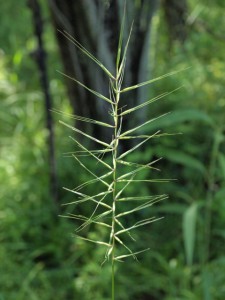 |
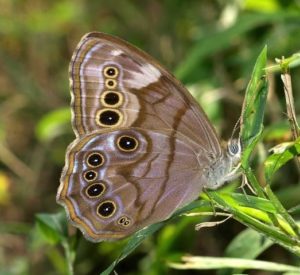 |
Bottlebrush Grass, or Eastern Bottlebrush, Elymus hystrix, is named for its long floral seed heads that resemble a bottle brush. It’s shade tolerant, so you can put it on the shady side of your garden or under trees for texture and interest. Grows 30–60 inches (0.8–1.5 m) tall. Soil: sand, loam. Moisture: dry, medium. Zones 3-7.
Rabbits love to browse its leaves, and Northern Pearly Eye Butterflies, Lethe anthedon, shown above, use it as a host plant for their caterpillars. (photos clockwise from top-left: Steve R. Turner, Missouri Botanical Garden / EOL – CC BY-NC-SA 3.0; Erin Faulkner / EOL – CC BY-NC 3.0; Howell C. Curtis / EOL – CC BY-NC-SA-3.0)
INDIANGRASS
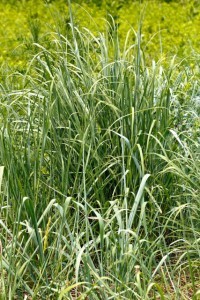 |
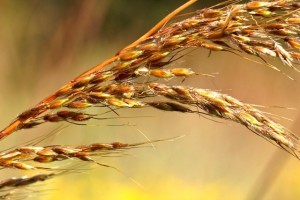 |
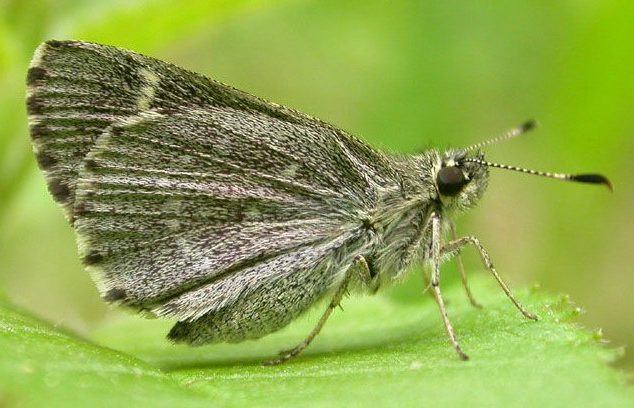 |
Indiangrass, Sorghastrum nutans, also called Yellow Indian Grass, is a perennial bunchgrass with blue-green blades that stay low to the ground most of the year and then grow 5–7 feet (1.5–2 m) tall before blooming from August to September. Soft, plume-like, orange to deep-purple seed heads have a somewhat metallic sheen. Looks best when planted in masses. Combine it with Little Bluestem and wildflowers for a pretty fall combination. Full sun. Tolerates most soil types. Moisture: dry to moist. Zones 3-9.
Indiangrass is appreciated by wildlife for cover, birds and small mammals eat its seeds, and the Pepper-and-Salt Skipper, Amblyscirtes hegon, shown above, uses it as a larval host. (photos clockwise from top-left: Tom Potterfield / Flickr – CC BY-NC-SA 2.0; Tom Potterfield / Flickr – CC BY-NC-SA 2.0; Jeffrey Pippen / EOL – CC BY-NC-SA 3.0)
BIG BLUESTEM
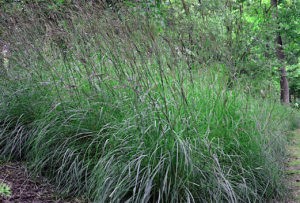 |
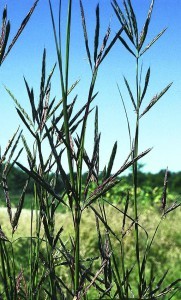 |
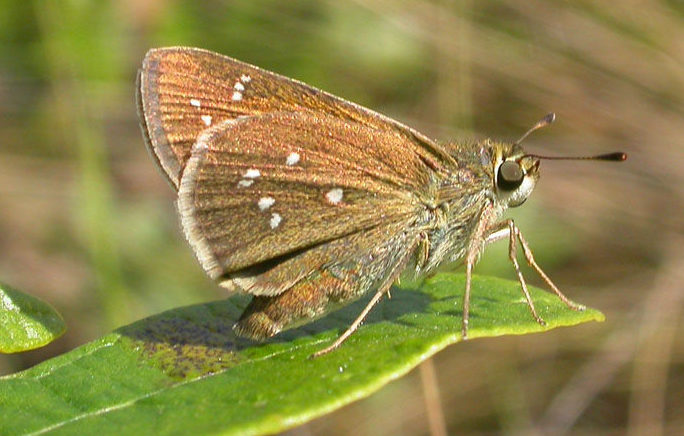 |
Big Bluestem, Andropogon gerardii, or Turkeyfoot, is the most widely distributed of all prairie grasses. A tall grass with seed heads that can reach 8–10 feet (2.5–3 m) high. Lush and green in summer, stems change to red-bronze with the first frost. Blooms from August to October. The seed heads branch into three parts, looking something like a turkey’s foot. Full sun. Any soil type. Drought-tolerant but benefits from some moisture; not too much, though, or it begins to droop. The State grass of Illinois and Missouri.
Big Bluestem provides good nesting cover and is a larval host for the Dotted Skipper (Hesperia attalus), shown above, and other skippers. (photos clockwise from top-left: T. Voekler / Wiki – CC BY-SA 3.0; Zoya Akulova / EOL – PD; Bill Bouton /EOL – CC BY-NC-SA 3.0)
How to design a backyard wildlife habitat
Native flowering plants
Provide cover for wildlife

